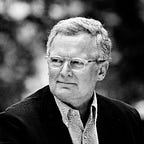A minimum viable organization
Physical tasks could normally be broken up in a reductionist way. Bigger tasks could be divided by assigning people to different smaller parts of the whole. For information tasks, it is much harder to find independent parts that make for an efficient workflow. These tasks are by default relational, complex and linked. There is typically no notion of a whole to start with.
The machine metaphor led to the belief that if we can only arrange the separate parts and their contributions in the right way, we optimize efficiency. The demands of work are now different: how efficient an organization is reflects the number of links people have and the quality of the links to the contexts of value creation, the things that matter. We are beginning to see the world in terms of relations.
How many handshakes separate people from each other from the things that matter most?
We have examples of social, digital architectures that redefine some basic beliefs about work and cooperation between people. The wiki was one of the best departures from the division of labor and workflows. Wikis let people work digitally together in the very same way they would work face-to-face.
In a physical meeting, there are always more or less the wrong people present and the transaction costs are very high. Unlike email, which pushes copies of the same information to people to work on, or edit separately, a wiki pulls people together to work cooperatively, and with very low transaction costs. The aim is a common movement of thought.
Email and physical meetings are methods which always exclude. They necessarily always leave people out. A wiki, depending on the topic, the context, and the people taking part, can be inviting and including. The goal is to enable groups to form around shared purposes without preset organizational walls, or rules of engagement.
In 1995 Ward Cunningham described his invention as the simplest online database that could possibly work. An important principle of the wiki is the conscious emphasis on using as little structure as possible to get the job done; as little organization as possible. It is a minimum viable organization. A wiki does not force a hierarchy on people; hierarchy is an emergent and dynamic phenomena. In this case, less structure and less hierarchy mean lower transaction costs. A wiki always starts out flat, with all the pages on the same level. It is a peer-to-peer structure. This allows people to dynamically create the organization and, yes, also the hierarchy that makes most sense in the different situations at hand.
People work together to reach a balance of different viewpoints through interaction as they iterate the content of work. The wiki way of working is essentially a digital and more advanced version of a meeting or a workshop. It enables multiple people to occupy the same space, see the same things and participate freely instead of inhabiting structural and mental silos. Some people might just listen, some make comments or small edits, while others might make more significant contributions and draw more significant conclusions. It is a long tail architecture.
New work is about responsive, free and voluntary participation by people who contribute as little, or as much as they want, and who are motivated by something much more elusive than only money.
Society has moved away from the era of boxes to the time of networks and linked, social individualism. Being connected to people, also from far away, is a cultural necessity and links, not boxes, are the texture of value creation.
Work is interaction between interdependent people. Every organization is in essence a wiki!
.
